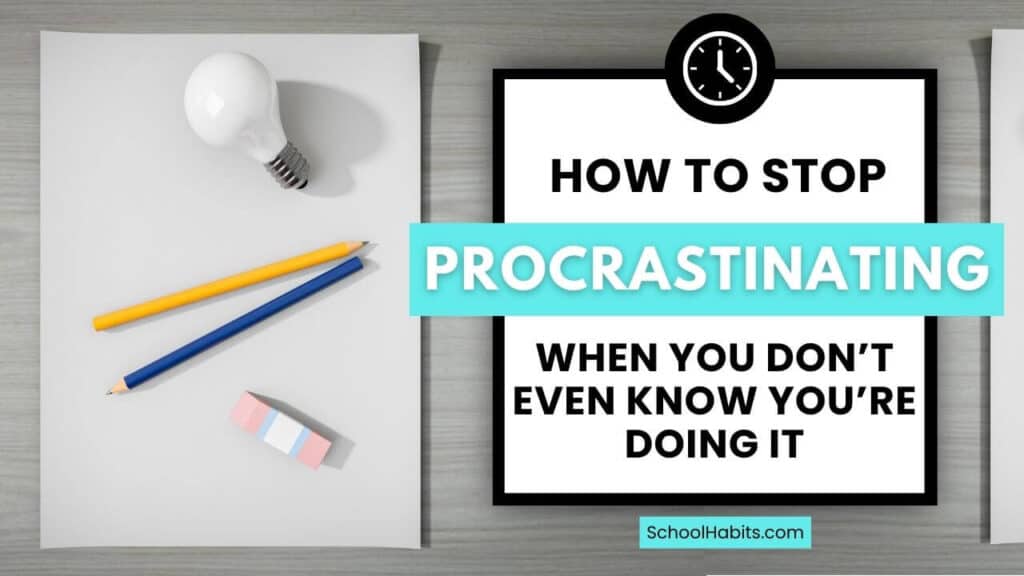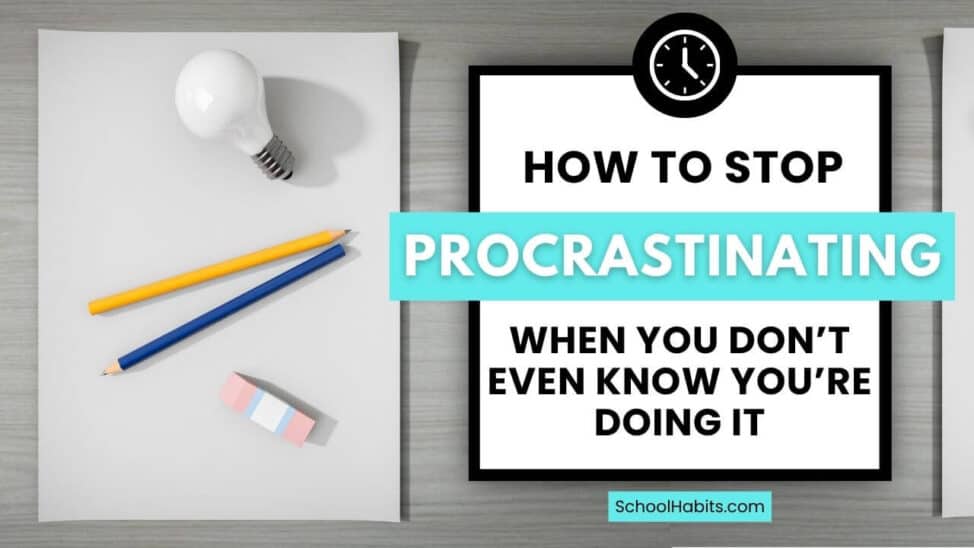
By Katie Azevedo, M.Ed.
We usually know when we’re procrastinating. We usually have a strong sense of I should really do this thing right now but I just don’t want to.
Where things get tricky is when our procrastination habits are so ingrained that we fool ourselves into thinking we’re doing the work, project or task we’re supposed to be doing – but we’re not.
In other words, we convince ourselves that we’re working on our projects when in reality, we’re working on the wrong part of the project.
This is the most dangerous form of procrastination because we think we’re being productive when we’re not.
In this tutorial, I’m sharing how to stop procrastinating when you don’t even know you’re doing it.
Signs You’re Procrastinating But Don’t Know You’re Doing It
When we don’t feel like doing the work, we sometimes do something that looks and feels like the work — but it isn’t.
This is a dangerous form of procrastination because we can really trick ourselves into believing we’re being productive.
A common sign that you’re procrastinating but don’t know you’re doing it is if you’re “working” on a project but not making any actual progress. You might:
- feel busy
- be surrounded by your materials (books open, tabs open, notes out, etc.) but you’re not using them
- tell yourself that you just have a little more research/setup/planning to do before starting
- be working on the “fun” part of the project but not on the project itself
It’s the last bullet point (#4) that I want to focus on. In so many cases, we procrastinate on an assignment, task or project by working on a “fun” element of the task but not on the most important element of the assignment.
Let’s look at three examples of what it could look like to procrastinate by working on the “fun” part of a task.
(Remember, this makes you falsely believe you’re doing the work — but you’re not.)
Example #1 of “fun” procrastination that you don’t know you’re doing:
You have to create a slideshow presentation about a famous person. Instead of researching and writing your slides, you spend all your time picking out the right template, playing with the color theme, and choosing a font. This is a classic example of procrastination that doesn’t feel like procrastination.
Example #2 of “fun” procrastination that you don’t know you’re doing:
You need to write an essay on a book you just read. But instead of sitting down and writing the essay, you’re spending your time color-coding your notes and annotations with pretty highlighters.
Example #3 of “fun” procrastination that you don’t know you’re doing:
You have a test to study for. But instead of making basic flashcards and using active recall to study them, you spent all your time making your flashcards look aesthetically pleasing.
In each of the above examples, you’re doing something related to the project so it feels like you’re making progress. It feels like you’re doing the right things. It feels like you’re working. But you’re not.
How to Stop Procrastinating When You Don’t Even Know You’re Doing It
I’ll bet by now, you’re wondering how to stop procrastinating when you don’t even know you’re doing it. Read on for the strategies. (If you have ADHD, use these strategies after reading the 4 below.)
1. Face Reality.
It’s perfectly fine to work on a “fun” part of a task, especially because at some point that part will have to get done. The trick is that you have to be honest with yourself that that’s what you’re doing.
It’s not the end of the world if you’re spending 20 minutes choosing the right font for your slide presentation; that’s not necessarily a horrible thing. But you need to call a duck a duck, and recognize that yes, you are procrastinating.
Again, the danger lies in telling yourself that you’re doing the hard work, when in reality, you’re just doing things related to the hard work.
2. Ask for Help and Get Clarity.
We often procrastinate when we don’t know what we’re doing. This is normal. If you’re unsure about how to complete a project or you don’t know the next step of what you’re working on, it makes sense that you would move to a more fun part of the project that is more clear.
For example, if you don’t know what to write your essay on, like in example 2, it would make sense for you to start color-coding your notes… Because that’s something you know how to do.
Again, the issue isn’t that you’re color-coding your notes: The issue only becomes an issue if you don’t admit that’s what you’re doing. It only becomes an issue when you tell yourself you’re working on your essay when you’re not. It only becomes an issue when you don’t recognize that you’re confused and don’t know how to proceed. Here’s what to do when you’re confused. And here’s a step-by-step tutorial for figuring things out.
3. Break Down the Steps.
The most basic approach for managing projects or long-term assignments is to break them into smaller steps. Every big-ish project is simply a series of smaller tasks that you complete one after another. This is Project Management 101.
For example, you don’t sit down and just bang out an essay in one sitting. There are multiple steps, including 1) do some research 2) take notes on your research 3) come up with a thesis 4) write an outline 5) write a draft 6) write your essay 7) edit the essay.
When you break down your larger projects into smaller steps, you’re better able to separate the real work from the fun work. And this is how you stop procrastinating when you don’t know you’re doing it. Separating the real work from the fun work is how you stop fooling yourself into thinking you’re being productive.
When you break down larger projects into smaller steps, you realize that things like pick a template, pick a font, and color-code my notes, aren’t really key steps at all.
4. Don’t Start with the Fun Part First.
The above 3 strategies all culminate in this one: Don’t start with the fun part first. When we do this, we delay the actual work, which is the very definition of procrastination.
Sure, there’s a time in place to work on the fun things and I’m not saying you shouldn’t. In fact, working on the fun parts is definitely better than not working on the project at all. In other words, I would rather you spend 20 minutes choosing your slide presentation template than playing a video game. But the point is, I want you to recognize that that’s what you’re really doing. Again, the whole point of this blog post is to draw attention to this dangerous kind of procrastination that disguises itself as work.
If you’re already drowning in late work, use these 6 tips for handling late assignments.
Final Notes About Procrastinating When You Don’t Even Know You’re Doing It
My goal is not to shame your procrastination. Heck, even I procrastinate and I am an anti-procrastination expert. (To prove this to you, here’s a list of 10 productive things to do when you feel like procrastinating.) The whole goal here is awareness. If you want to procrastinate on something you should be doing, then go ahead and do that. (Kills me to write that, but I mean it.)
But what I don’t want you to do is continue to fool yourself into thinking you’re working when you’re not.
Again, this is a dangerous form of procrastination because you’ll end up disappointed in yourself, the work won’t get done, and you’ll be left wondering what the heck happened.

